The joy of cycling—feeling the wind on your face, the thrill of speed, and the freedom of the open road. But what happens when each pedal stroke brings a sting of pain in your knee, turning your favorite pastime into a daunting challenge? If you’ve found yourself hesitating before a ride, fearing the discomfort that might follow, you’re not alone. But what if the solution was not in hanging up your cycling shoes, but understanding and addressing the root of the issue? Dive in as we pedal through the causes of cycling-induced knee pain and explore easy, effective ways to get you back on the track, pain-free.
Contents
Why Does My Knee Hurt While Cycling?
 Cycling, though a low-impact exercise, requires complex interplay between various muscle groups, joints, and the bicycle itself. When this harmony is interrupted, pain can emerge. Here’s a closer look into the biomechanics and the responsibilities shouldered by your knees during cycling:
Cycling, though a low-impact exercise, requires complex interplay between various muscle groups, joints, and the bicycle itself. When this harmony is interrupted, pain can emerge. Here’s a closer look into the biomechanics and the responsibilities shouldered by your knees during cycling:
- Cycling involves continuous repetitive knee flexion and extension. Over thousands of pedal strokes, even minor misalignments or muscle imbalances can cause significant stress on the knee.
- While pedaling, especially uphill or against resistance, the knee bears a significant load. This pressure amplifies if the saddle height is incorrect or if there’s an improper foot position on the pedal.
- Cycling predominantly engages the quadriceps. If they become overly dominant or tight, they can pull on the kneecap, causing pain.
In essence, while cycling offers an exhilarating way to stay fit, the repetitive nature of the activity combined with the specific pressures placed on the knee joint make it crucial for riders to ensure proper form, muscle balance, and bike fit.
The Main Culprits Behind Cycling-Induced Knee Pain

Cycling offers a multitude of benefits, from cardiovascular fitness to stress reduction. However, the repeated pedal revolutions can sometimes introduce pain, especially if certain aspects of your cycling routine or setup aren’t quite right. Here are the most common culprits behind knee discomfort in cyclists:
Improper Saddle Height
- Too High: If the saddle is too high, your knee will overextend with every pedal stroke, leading to strain on the back of the knee.
- Too Low: A low saddle can cause the knee to remain overly bent throughout the pedal stroke, stressing the front of the knee and compressing the kneecap against the femur.
Wrong Saddle Position
- Too Far Forward: A forward saddle can shift more weight onto the knees, causing them to bear undue stress.
- Too Far Backward: This can make your hip angle too acute at the top of the pedal stroke, straining the hamstrings and the back of the knee.
Incorrect Pedal or Cleat Position:
- Misaligned Cleats: If the cleats force your foot to angle inwards or outwards, it can affect knee alignment during pedaling, leading to lateral knee pain.
- Pedal Width or Q-Factor: The distance between your pedals, known as Q-factor, can impact how your knees track. Too wide or too narrow, and it can cause the knees to move inward or outward, respectively.
Muscle Imbalances and Tightness
- Dominant Quadriceps: Cyclists often develop strong quads. Without balanced strength in the hamstrings, the kneecap can be pulled out of alignment.
- Tight IT Band: The iliotibial (IT) band runs along the side of the thigh. If it’s tight, it can pull the kneecap sideways, causing pain on the outer knee.
- Weak Hip Muscles: Hips play a role in stabilizing the upper leg. Weak hip muscles can allow the thigh to rotate inwards, leading to misalignment and pain.
Riding Technique and Cadence
- Mashing the Pedals: Pushing down hard in a high gear can put excessive pressure on the knees. Maintaining a smoother, higher cadence in a lower gear can be gentler.
- Improper Warm-Up: Just like any other sport, diving into intense cycling without a proper warm-up can lead to injuries and pain.
Equipment Misfit
- Wrong Shoe Type: Cycling shoes that don’t offer proper arch support or are too tight can influence foot and knee alignment.
- Old or Worn-Out Equipment: Using worn-out pedals, shoes, or cleats can subtly alter pedaling mechanics, introducing strain.
Recognizing and addressing these factors can be the key to pain-free cycling. Regular bike check-ups, combined with attention to form and muscle balance, can prevent most knee issues related to cycling.
At Home Remedies To Fix Cycling-Induced Knee Pain
 When knee pain strikes post-cycling, there’s no need to despair. There are several at-home remedies and self-care techniques that can provide relief and accelerate recovery. Here are some strategies you can deploy:
When knee pain strikes post-cycling, there’s no need to despair. There are several at-home remedies and self-care techniques that can provide relief and accelerate recovery. Here are some strategies you can deploy:
- RICE Protocol:
- Rest: Give your knee a break and avoid activities that aggravate the pain.
- Ice: Apply an ice pack for 15-20 minutes every 1-2 hours during the first 48 hours. This will help reduce inflammation and numb the area.
- Compression: Use a compression bandage or knee brace to reduce swelling.
- Elevation: Raise the affected knee above heart level to decrease swelling.
- Over-the-counter Pain Relievers: Non-prescription NSAIDs (Non-Steroidal Anti-Inflammatory Drugs) like ibuprofen can reduce pain and inflammation. However, it’s essential to use them as directed and ensure they don’t interfere with any other medications.
- Stretching: Gentle stretches targeting the quadriceps, hamstrings, calves, and IT band can help relieve tension and improve flexibility.
- Strengthening Exercises: Incorporate exercises like squats, lunges, and leg lifts to strengthen the muscles around the knee, which can provide better support and alignment.
- Warm Up and Cool Down: Before jumping on your bike, ensure you warm up adequately with dynamic stretches and a slow pedal pace. After your ride, cool down with some static stretches and deep breathing.
- Massage: Gentle massage around the knee and thigh muscles can help in relaxing the muscles and improving blood flow.
- Correct Cycling Form: Pay attention to your cycling form, ensuring you pedal in circles rather than pushing down or pulling up aggressively.
- Adjust Bike Settings: If you suspect your pain might be due to improper bike settings, consider getting a professional bike fit. In the interim, small adjustments to saddle height, saddle position, or cleat alignment might offer relief.
- Stay Hydrated: Drink plenty of water before, during, and after cycling. Proper hydration can help flush out toxins and prevent muscle cramps.
Remember, while these remedies can offer relief, it’s essential to listen to your body. If the pain persists or intensifies, it might be time to consult a professional for a thorough evaluation and personalized guidance.
Stretching & Strengthening: Exercises for Cyclists
For cyclists, maintaining strong and flexible muscles around the knee is pivotal. Not only does this ward off potential injuries, but it also ensures optimal power output and efficient pedal strokes. Here’s a compilation of both stretching and strengthening exercises tailored for cyclists:
Stretching Exercises
Quadriceps Stretch (Front thigh muscle)
 How to: Stand on one leg, holding onto a wall or chair for balance. Grab your opposite ankle with your hand and gently pull it towards your buttocks until you feel a stretch. Hold for 20-30 seconds and switch legs.
How to: Stand on one leg, holding onto a wall or chair for balance. Grab your opposite ankle with your hand and gently pull it towards your buttocks until you feel a stretch. Hold for 20-30 seconds and switch legs.
Hamstring Stretch (Back thigh muscle)
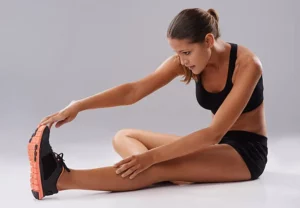 How to: Sit on the ground with one leg extended out and the other bent, foot touching the inner thigh of the extended leg. Lean forward from the hips, trying to reach the toes of the extended leg. Hold for 20-30 seconds and switch legs.
How to: Sit on the ground with one leg extended out and the other bent, foot touching the inner thigh of the extended leg. Lean forward from the hips, trying to reach the toes of the extended leg. Hold for 20-30 seconds and switch legs.
Calf Stretch
 How to: Stand arms-length away from a wall. Place one foot behind the other and bend the front knee while keeping the back leg straight and heel on the ground. Push against the wall until you feel a stretch in the calf of the back leg. Hold for 20-30 seconds and switch legs.
How to: Stand arms-length away from a wall. Place one foot behind the other and bend the front knee while keeping the back leg straight and heel on the ground. Push against the wall until you feel a stretch in the calf of the back leg. Hold for 20-30 seconds and switch legs.
Hip Flexor Stretch
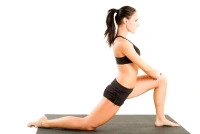 How to: Start in a lunge position with one foot forward and the other stretched back, toes pointing downward. Push your hips forward until you feel a stretch in the front of the hip on the trailing leg. Hold for 20-30 seconds and switch sides.
How to: Start in a lunge position with one foot forward and the other stretched back, toes pointing downward. Push your hips forward until you feel a stretch in the front of the hip on the trailing leg. Hold for 20-30 seconds and switch sides.
Strengthening Exercises
Single Leg Squats
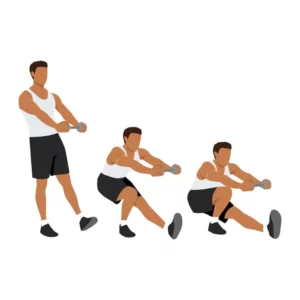 How to: Stand on one leg with the opposite leg extended in front. Slowly lower yourself into a squat, ensuring your knee doesn’t go beyond your toes. Push back up and repeat for 10-15 reps on each leg.
How to: Stand on one leg with the opposite leg extended in front. Slowly lower yourself into a squat, ensuring your knee doesn’t go beyond your toes. Push back up and repeat for 10-15 reps on each leg.
Bridges
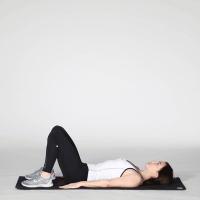 How to: Lie on your back with your knees bent and feet flat on the ground. Tighten your core and lift your hips off the floor until your body forms a straight line from shoulders to knees. Hold the bridge position for a few seconds, then lower. Repeat for 12-15 reps.
How to: Lie on your back with your knees bent and feet flat on the ground. Tighten your core and lift your hips off the floor until your body forms a straight line from shoulders to knees. Hold the bridge position for a few seconds, then lower. Repeat for 12-15 reps.
Lateral Leg Raises
 How to: Lie on your side with your legs stacked. Keeping your leg straight, lift the top leg towards the ceiling, then slowly lower it. Perform 10-15 reps on each side.
How to: Lie on your side with your legs stacked. Keeping your leg straight, lift the top leg towards the ceiling, then slowly lower it. Perform 10-15 reps on each side.
Clamshells
 How to: Lie on your side with legs bent at a 90-degree angle, feet together. Keeping your feet touching, lift the top knee as high as possible without moving the pelvis. Slowly lower it. Do 10-15 reps on each side.
How to: Lie on your side with legs bent at a 90-degree angle, feet together. Keeping your feet touching, lift the top knee as high as possible without moving the pelvis. Slowly lower it. Do 10-15 reps on each side.
Step-ups
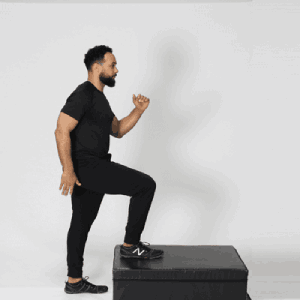 How to: Stand in front of a step or bench. Step up with one leg, bringing the other knee up towards the chest. Lower it back down and repeat for 10-15 reps on each leg.
How to: Stand in front of a step or bench. Step up with one leg, bringing the other knee up towards the chest. Lower it back down and repeat for 10-15 reps on each leg.
Regularly incorporating these exercises into your routine can bolster the muscles supporting the knee, ensuring a pain-free and powerful pedal stroke.
When to Seek Professional Guidance
While minor aches can be a natural byproduct of intense physical activity like cycling, it’s crucial to discern between typical soreness and signs of something more serious. Knowing when to seek professional guidance can save you from long-term complications.
- Persistent Pain: If your knee pain doesn’t subside even after trying self-care remedies or taking a break from cycling, it could be an indication of an underlying issue.
- Swelling and Inflammation: Some post-ride swelling can be standard, especially after a rigorous session. However, if the swelling remains for more than 48 hours or is accompanied by redness and warmth, it’s essential to consult a medical professional.
- Limited Range of Motion: If you find it challenging to fully extend or bend your knee, or if you feel a locking sensation, this could be a sign of potential ligament, tendon, or cartilage damage.
- Audible Sounds: Crunching or popping sounds, especially if they’re accompanied by pain, are not to be ignored. These could be symptoms of meniscal tears or other issues.
- Instability: If your knee suddenly feels weak or as if it might give out, this can be a sign of an injury that needs immediate attention.
- Significant Bruising: While minor bruises are standard with minor bumps, a large, deep bruise can indicate a more severe injury like a bone fracture or deep tissue damage.
Remember, your body is adept at sending signals when something isn’t right. Do not downplay or ignore these signs. Early intervention can prevent minor issues from becoming major complications. Seeking advice from a physical therapist or doctor can guide you on the right path to recovery.
Conclusion
Cycling is not just a mode of transportation; for many, it’s a passion and a way to stay fit. However, like all physical activities, it comes with its set of challenges, and knee pain can be a significant one. Understanding the root causes, practicing preventive measures, and adopting the right exercises can go a long way in ensuring that you pedal pain-free. If you’re experiencing knee pain, don’t let it deter your cycling spirit. Physical therapy for knee pain at PhysioMantra can guide you back to the path of comfortable cycling. Don’t hesitate—Book an online physical therapy session today. Safe cycling!



